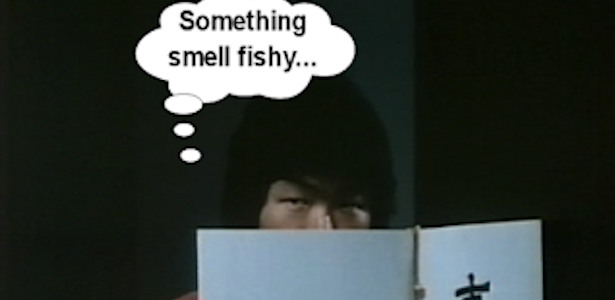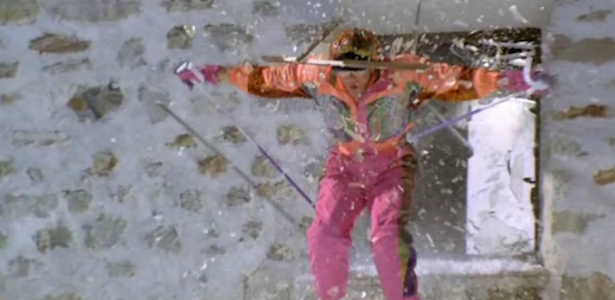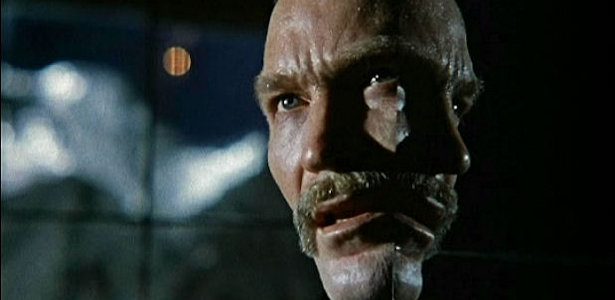Damn, it's almost April and I haven't posted pint-sized ramblings about some of the amazing stuff I took in. While I've been revisiting a lot of old favorites in HD (I was never really sold on old movies in squeaky clean digital formats until I revisited BLADE RUNNER on blu-ray), here's a minor sampling of random flicks:
PRISON (1988): Honestly, I'm shocked at how well this movie has aged. The new transfer from Shout Factory really throws that into sharp relief with the lush cinematography being beautifully represented in a new widescreen presentation. Will throws the switch here. This impressive production was made right before the collapse of Empire pictures, making their demise even more bitter. There's a huge amount of talent on a very small budget and it really comes together dead on target without a wasted minute. On the casting side, we have Lane Smith as the prison warden, who not only has a subtle character arc that would be completely flattened in a modern genre film, but he chews the grim, neo-gothic scenery to just the right degree. Even when wide-eyed, sweaty and drooling, he never crosses the line into camp. Of course there's this guy named Viggo who I don't think went anywhere after this, Hal Landon Jr, who once again is a guy with a badge who has his keys stolen ("Deputy Van Halen?"), "Tiny" Lister who actually shows a surprising range of emotions, and Irwin Yablans' son who had the opportunity of playing the "special friend" of "Rhino" (the very real convict Stephen E. Little who was shackled in full restraints when the camera wasn't running). A real sleeper classic that never really got its due until now.
Screenwriter Michael Tolkin's messages are writ pretty large in this movie. One being the "Asian menace" theme, the other is that being a member of a fringe group that does not conform to mainstream acceptance is not only bad, but will make you unpopular, unlayable and your parents will hate you. Ok, so that last part might be true. At one point in the movie Brian realizes that he needs to essentially dress preppy with a sweater, khakis and loafers in order to gain acceptance, from what appears to be the entire planet, and get the drop on the bad guys.
 |
| Hijole de la chingada! Check out the price of gas in LA! |
BUSTING (1974): Peter Hyams has had a wildly erratic career as a director, but you can't accuse him of following the herd, not even when he has formula stars like Arnold Schwarzenegger and Jean-Claude Van Damme in front of the camera. Here, in his first feature film, Hyams directs Elliot Gould, known for making weird films, and Robert Blake, known for being weird. Even though this follows a trend of early '70s disillusioned cop movies (1972s THE NEW CENTURIONS arguably being the poster child for this sub-genre), it definitely marches to the beat of its own drum. Gould and Blake play Keneely and Farrel, a pair of shabby, cynical vice detectives who have good intentions, but seem to make a hash out of a simple bust of a high-class hooker. The minor foul-up is less important than the fact that she has friends in high places who don't want to see her busted, nor her crime boss Rizzo (Allen Garfield) who seems to have bought off the entire Los Angeles police force. Every time they try to follow up on Rizzo, they get knocked down by the chief who is being told to put Keneely and Farrel on a short leash. In addition to the off beat performances (Blake seems like he was shot-up with thorazine before every scene), there are bizarre "comic" sequences of the duo being put on menial tasks such as hanging out in a men's public toilet waiting to be propositioned or better still, being ferociously attacked by a mob of cross-dressers in a gay bar that is envisioned with red lighting and hand-held camera work. The punchline to the latter scene is Keneely leaning up against a car while Farrel examines a bite on his leg, rhetorically composing a letter to his parents "Dear Mom and Dad, how are you doing? I am swell. Fag ate my leg. Your son, Michael." Trust me, I'm not taking that out of context. Hyams ropes in a few cool bit players as well, with Antonio Fargas playing a catty queer (again), Sid Haig as one of Rizzo's henchmen and even Michael Lerner shows up briefly. Imagine THE NEW CENTURIONS (1972) on pills and dope with don't-give-a-shit attitude and you kind of get the picture.
HOT STUFF (1979): In his massive career spanning over 50 years of television and film, Dom DeLouise only directed one feature film and this is it. Personally, I think if you are going to direct only one feature film in your half-century career it should be written by Donald Westlake with a title song by Jerry Reed. I think that's fair.
A group of frustrated undercover cops (DeLouise, Jerry Reed, Suzanne Pleshette and "The Electric Company's" own Luis Avalos) get tired of trying to bust the perps the hard way. You know, with warrants, miranda rights and random ball shots. Also plaguing their careers is the wrath of their hot-tempered chief (Ossie Davis) who wants them to go by the book, goddammit! Seems that whole angle isn't working, so they get the idea to set up a pawn shop where they can pretend to be fences allowing them to videotape the scofflaws in the act of selling their stolen goods. Once the team has spent all of the department's money on buying up stolen goods, they'll just round everyone up and arrest them. What could go wrong?
Ok, I'm not going to try and sell you some line about this being a piece of subversive cinema in mainstream clothing, but it does have a nice grimy backdrop.
 Westlake (with the help of ham-handed script-doctor Michael Kane) dial in a nice combination of freewheeling action and what basically amounts to stand-up comedy cameos. Additionally, in spite of Burt Reynolds' conspicuous absence (apparently too busy with the 1979 romantic comedy STARTING OVER), we still get Trans Am action sequences, though it does amazingly transform into a beat-up Camero right before it is blown up by the mob. When I was a kid I was fascinated by Stockton, California's seedy bars, pool halls and pawnshops (which puts me in good company as FAT CITY was famously shot there in '72). Maybe that's why this movie made such an impression. Watching this through a kid's eyes in a Stockton theater made it seem like this could be happening right down the street. Though I really couldn't fathom what was so damn funny about those skinny cigarettes.
Westlake (with the help of ham-handed script-doctor Michael Kane) dial in a nice combination of freewheeling action and what basically amounts to stand-up comedy cameos. Additionally, in spite of Burt Reynolds' conspicuous absence (apparently too busy with the 1979 romantic comedy STARTING OVER), we still get Trans Am action sequences, though it does amazingly transform into a beat-up Camero right before it is blown up by the mob. When I was a kid I was fascinated by Stockton, California's seedy bars, pool halls and pawnshops (which puts me in good company as FAT CITY was famously shot there in '72). Maybe that's why this movie made such an impression. Watching this through a kid's eyes in a Stockton theater made it seem like this could be happening right down the street. Though I really couldn't fathom what was so damn funny about those skinny cigarettes.TOTAL RECALL (2012): Well, since you asked, my opinion of Colin Farrell hasn’t changed in the slightest. I’d say he was miscast, but that implies that there is a role that he would be good in. As for this film, it’s amazing how much stuff they rip off from movies that they are not remaking. They did a great job of re-creating Mega City 1 and Los Angeles 2019. You see, the basic premise is that there are only two inhabitable areas left on earth. Both are highly compact city states, like I dunno… a “mega” city. On one side of the Earth we have the affluent, totalitarian UK (blatantly stolen from "Judge Dredd" comic books) and on the other side of the Earth is the poor downtrodden Down Under (blatantly stolen from BLADE RUNNER). There is a massive shuttle transport that runs through the center of the earth in between the two, mainly to ferry poor menial laborers from the oddly dystopian outback into the unsurprisingly Germanic Pommyland to assemble military robots. As a political ploy the prime minister of the UK (*spoilers!*) sets up a rebel movement in Oz, so that he will have an excuse to invade with the robots the their own population has assembled. It's not really a remake of the Schwarzenegger film (which bizarrely is now being vaunted as a "classic" of the genre), though it does throw in a few reworkings of "classic" bits from that film that are about as welcome as a homeless guy at a Republican convention. Just in case you were wondering, the tri-boobed prostitute was not in the original Philip K. Dick story. On the plus side, those bits are the only parts of the film that fall into camp.
 |
| He say you... eh, you know. |
 |
| Who is the Law? |
Personally, I didn’t hate it. It fumbles a lot of stuff (like casting Farrell and Jessica Beil), but it’s definitely not a remake. There are three or four scenes that deliberately echo the Arnold movie and I don’t know why they even bothered. Maybe that was something else that Columbia demanded. They changed some stuff back to the way it is in the original PKD story, but then changed other stuff to make it a high concept Hollywood film. Interestingly while in the theatrical film Farrell receives video-recorded messages from his own post Rekal self, in the director's cut we have Ethan Hawke leaving those messages. I think this is the one time in my life that I've been delighted to see Ethan Hawke in a movie.
This version of TOTAL RECALL really doesn’t hold much to the source material, borrowing liberally from other films, but it’s definitely closer than the Paul Verhoeven film. That's got to count for something.





























































